I want to reaffirm that what follows is my own personal opinion, and should be taken as generalized information on this topic, not personalized investment advice for your particular situation.
I say this caveat because the following topic is complicated. Every investor’s reasons to begin peer to peer lending are different. Some investors are multi-million dollar institutions simply looking to give high returns to their clients. Others are middle class retirees who want a secure place to protect their cash from inflation. The needs are very diverse.
That said, I think there is a way forward. The fact is, the average American invests for one sole reason: saving for retirement. Most investors are simply looking to sock away enough money to live off later in life when they are too aged to work and just want to spend time with their grandchildren. As long as investments like stocks and bonds are held beneath that goal, the place of peer to peer lending alongside them becomes much clearer.
How Much Should You Invest in Peer to Peer Lending?
Many people wonder what the “correct” sized investment is at Lending Club or Prosper. Obviously, everybody’s needs are different. That said, p2p investments can usually be placed into one of three buckets:
#1 – Trial investments: “People are talking all about this peer to peer lending thing. Is this like Kiva? Maybe I’ll invest just $2,000 in 80 A-grade notes and see what happens.”
#2 – Alternative investments: [One year later] “Wow, just one of my 80 loans defaulted, and I earned a great 5% return. I’m going to move over $10,000 and increase my risk into some lower grade loans.”
#3 – Main investments: [One year later] “This is amazing. My $12,000 investment has earned a solid 7% return for the past two years! Having done the research, I trust peer to peer lending. I’m going to include it with stocks and bonds as one of my main investments. But what portion of my investments should it have?”
The third bucket is what we’ll talk about today. This is because when people ask the “How much?” question, they are typically serious investors asking about the percentage that it should hold within their overall portfolio. But it’s hard to say what portion p2p lending deserves without saying how it relates to other investments as well.
The main two investments in the United States are stocks and bonds. So let’s reframe the question. How much of our investment should be in stocks, bonds, and peer to peer lending?
Saving for Retirement Changes with Age
If a financially secure retirement is the finish line, then our investment choices should be focused on reaching that goal. This happens in two ways:
- Investing our money when we are younger
- Protecting our money when we are older
When you are younger, you typically have many decades ahead of you where you can hold a job, so you can take on more risk. After college, did you pour your entire savings into a new business that failed? No problem. Get another job, build up your savings, and try again.
But if you lose your entire savings at age 80, you’re in serious trouble. Your body can’t work like it used to, so being that risky with your savings is a really bad idea.
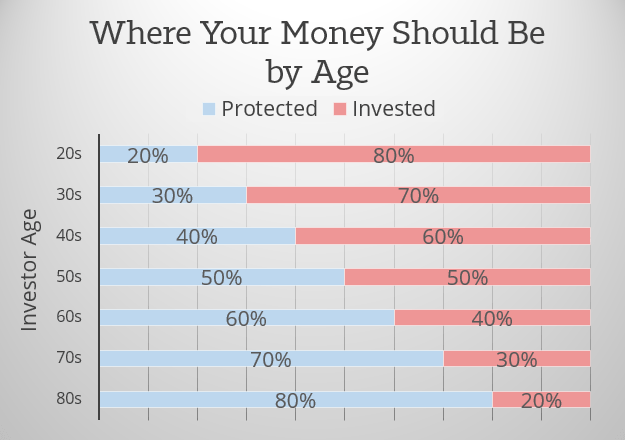
People are typically advised to invest a greater portion of their money when they’re younger, and protect their savings as they grow older. Traditionally, a rule-of-thumb has been to protect the portion of your money that is the same as your age. For example, people who are 30 years old could have 30% of their money protected from loss, and 70% of their money in investments that could make it grow.
As seen in the above chart, you should be increasing your protected savings as your ability to earn money decreases. Your younger years enable you to enjoy your old age in security and happiness.
How do people typically grow vs. protect their saved cash? Stocks vs. bonds.
(Note: your net worth should be spread across a variety of asset classes like real estate, cash, and private equity. Today we will just focus on stocks and bonds, but the notion of growth vs. protection works across them all.)
Grow it with Stocks, Protect it with Bonds
Stocks and bonds have become the go-to instruments to secure America’s retirement. This is because stocks have historically offered the highest return, while bonds have historically offered more safety.
Stocks are a great growth-investment
It is really hard to find a investment that beats stocks in terms of a great return. Here is the Dow Jones Industrial Average, a popular index of the US stock market.
The American stock market has often returned investors a great 10% per year. Its great track record brings millions of Americans to trust it as their main growth-investment. That said, see the area highlighted in yellow? This was a decade where the stock market basically earned no return at all.
In short, the stock market offers investors a great return. But it is not very stable.
Bonds offer great protection
On the other hand, bonds are a much safer place to protect your money. Here is how the bond market performed in the madness of 2008 compared to stocks:
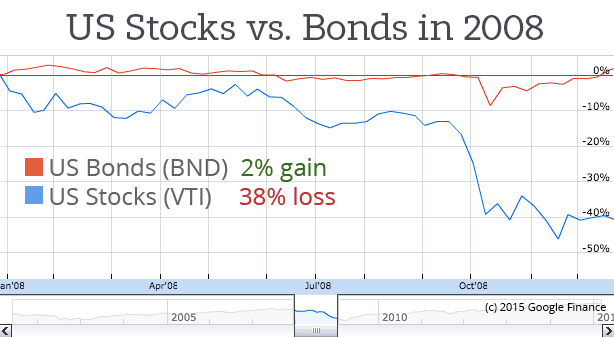
2008 was an ugly year for stock investors. They looked on as their investment lost over a third of its value. In contrast, bonds in 2008 gave investors a 2% positive return. In fact, over the past 90 years, the bond market has had just one 10-year period that lost investors money (-0.8% return ending in 1959). On top of this, bonds earn a decent return that protects our savings against inflation: 10-year treasury bonds returned investors an average of 7.8% for the past 40 years.
Investing in Stocks versus Bonds by Age
In short, bonds offer investors more safety, but the returns are better in stocks. As a result, we get the following chart:
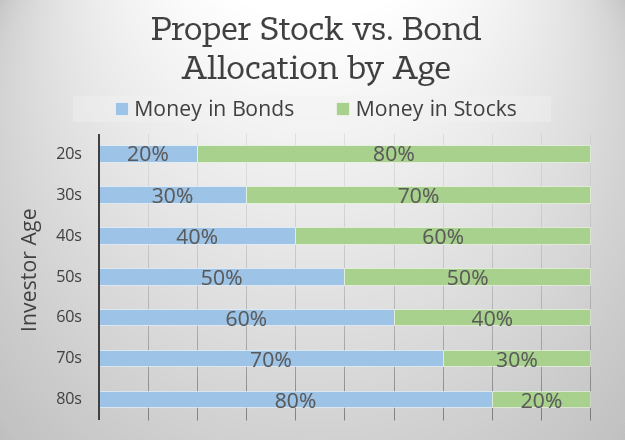
When you’re younger, you have lots of time to recover from major stock market swings. But as you age, you move more money over from stocks to bonds, protecting it for future years. For example, if you had placed 80% of your savings in bonds during the crash of 2008, your portfolio’s overall value would have fallen by just 6%, great news for 80 year olds who can’t really go back to work.
Target Date Funds: Many companies offer their employees a “target date” fund, setting a particular year (like the year 2040) as your eventual retirement date. If you have one of these, your fund is probably already doing the steps above, moving you away from risk as you get older. Vanguard explains reallocation well in this graphic.
P2P Lending: Useful as a Stock or a Bond
Interestingly, investments at companies like Lending Club or Prosper can act both like a stock (growing your savings) or a bond (protecting your savings). For example, 2009 was a rough year for p2p borrowers (unemployment was 10%). On the other hand, 2010 was more typical. Here are the two years side by side (hat tip to NSR):
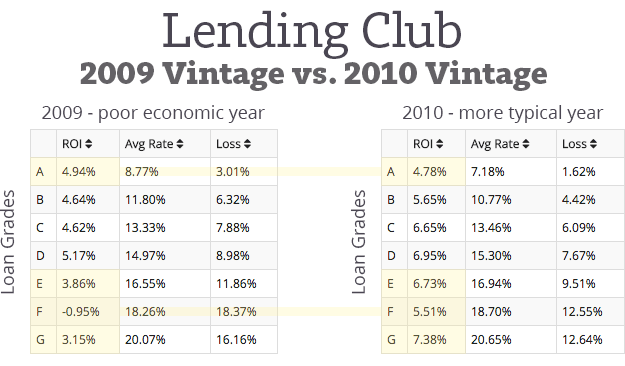
Safer p2p grades: Even though unemployment in 2009 was at a 25-year high, the return of A-grade loans was solid. And the 5% ROI would have been a great return vs. inflation. In contrast, the return of riskier E-G grade loans fell below 5%. Basically, your money is more protected in A-grade loans.
Riskier p2p grades: On the other hand, D-G loans offer a much higher return, usually 7-9%. So in a more typical economic climate, riskier low-grade loans are a much better growth-investment. Personally, I’m earning around a 10% return per year in them.
How Peer to Peer Lending Fits with Stocks and Bonds
If we realize that peer to peer lending can both grow and protect our cash, we have the ability to insert it into our overall retirement plan:
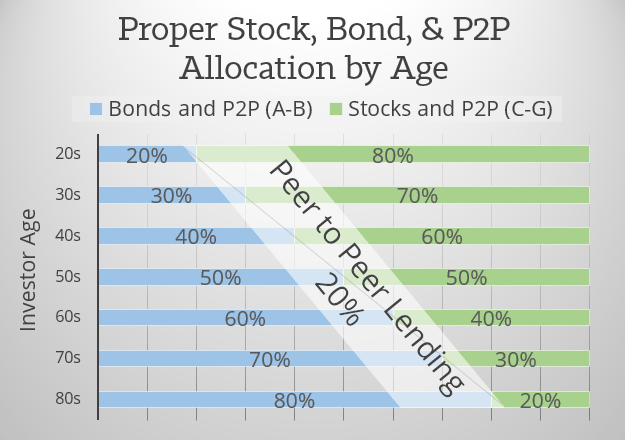
Year by year, the exact same 20% portion could remain invested. It simply shifts to safer loan grades as you get closer to retirement.
 Example: let’s say Jennifer, an accountant in her early 50s, is choosing how to save for retirement. Following this chart, she could protect 40% of her savings in bonds and 10% in Lending Club loans (A-B grades). She could then grow her savings through 40% in stock market index funds with another 10% in Prosper loans (C-E grades).
Example: let’s say Jennifer, an accountant in her early 50s, is choosing how to save for retirement. Following this chart, she could protect 40% of her savings in bonds and 10% in Lending Club loans (A-B grades). She could then grow her savings through 40% in stock market index funds with another 10% in Prosper loans (C-E grades).
I feel good about holding 20% in peer to peer loans.
This investment used to be unproven. Early on, it was really important for everybody to test the waters and make sure peer to peer lending was safe. But times have changed. Not only have some of the largest (Google) names (BlackRock) in America given Lending Club and Prosper their stamp of approval, but we have many years of history that show how p2p lending performs (both in rough climates like 2009 and good climates like today).
In that way, I feel comfortable suggesting 20% as a lifetime allocation for investors – given they adjust their loan grades each year (perhaps with 10% in each platform to remain in their guidance). A 20% portion seems both reasonable and significant. In fact, considering the stability of these returns compared to the wild nature of the stock market, I think people who avoid this investment are missing out on a crucial way to steady their retirement account across another asset class. Those of us who adopted peer to peer lending early on may enjoy noticeably better financial situations in retirement than those who did not.
What about you? What portion of your overall portfolio is in peer to peer lending?
[image credit: ‘Hope and Wisdom‘ by Todd Baker
‘Istanbul – Oct 2008‘ by Gareth Williams CC-BY 2.0]

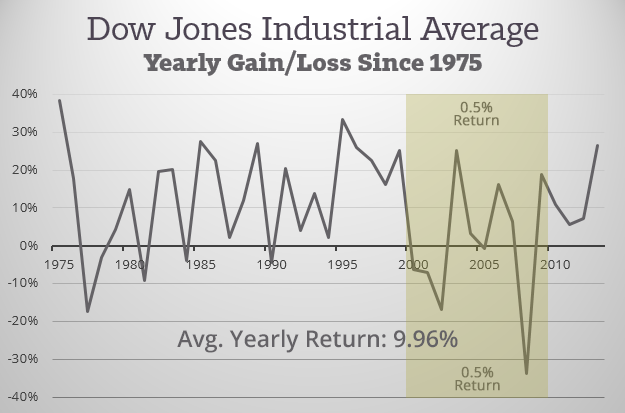
Great article… I’ve been asking myself this very question of whether P2P investments are more like bonds or stocks–your answer about how it depends on the loan grades makes perfect sense, and in today’s bond climate, the higher grade loans are giving better returns as a protected investment than most bonds. In a sense, the ability to adjust loan grade at a finer grain than just stocks vs. bonds gives us more control over the risk in our portfolios.
Thanks Jeff. Great point about today’s bond climate.
Great post Simon.
This may be contrarian, but I personally have been 100% invested in P2P assets of different kinds (consumer credit, business loans, HML etc). This has been going on for the past 8 years so I have experience. I find this asset class easier to understand, simple and mostly free from manipulation. I initially did stocks, but this (not just consumer credit, I diversify within debt) has replaced equities for me completely. I by no mean am promoting folks do this, but thought this may be an interesting data point. As an aside, quite a few of us “retail” investors exist with large portfolio in debt, contrary to popular belief.
Hope to see you at Lendit.co and talk.
Thanks for sharing Rav. While I think the general public may eventually get there with time, the stock market still continues to provide better returns year over year than 99% of peer to peer lending accounts. In this way, I’m a big believer in low-cost index funds like Vanguard’s Total Stock Market (VTI). Retirement is a 40-year process for most. I would rather lean into investments that have had 40 years of retail investing history.
Perhaps in the next 5-10 years we’ll have something with higher returns, like a p2p credit card or something, but for now I think most people are wise to lean into stocks as their primary growth investment.
is it better to use the automated investor? im starting with 1,000 very small amount
Dude, Epic Post!
I love the way you laid everything out so nicely. P2P has certainly grown exponentially over the years.
This is the one place I feel comfortable committing new capital right now. The consumer lending market has been a very profitable one through good times and bad times. The credit card industry exist for a reason.
Consumer Debt is great when you are a lender and can be crippling as a borrower, especially if you are borrowing from some of the big banks.
P2P is a win/win. The borrowers get more favorable rates, and the lenders get to earn a respectable return.
Cheers!
Thanks brotha. Glad you’re so big on this thing. Win/win indeed!
Thanks for this post and to many thoughtful add-on commenters. This exact question has been on my mind and I’m now flirting with the step 3 decision….
Is there any evidence of P2P lending working well for investors with 6 figure accounts rather than my ‘still-cautious’ 4 and 5 figures current levels of investment? It seems a logical presumption, but facts are very nice…
Hi Ron,
Short answer. Yes. I know several folks who have invested well north of 6 figures in P2P + Real estate + Business loans platforms and are doing quite well. What people need to realize is that the major platforms haven’t faced 2008 style recession. Comparing this asset class to credit card defaults is incorrect IMHO and I may have a blog post on it soon, as to why we may see higher defaults with data analysis.
Cheers.
Hi Ron. Actually the majority of cash in p2p loans comes from investors with over 6 figures. Ie: institutional investors are how Lending Club and Prosper hit profitability.
Great piece, Simon! Here’s a related white paper I collaborated on with a certified financial planner and self-directed retirement expert: http://daraalbright.com/2015/04/13/financial-advisors-please-meet-p2p-p2p-online-or-marketplace-lending-or-whatever-you-want-to-call-yourself-please-meet-financial-advisors/
I have been investing in LendingClub since November 2014. I’m very new on this and I have the following allocation right now in my notes A-11%, B-33.5%, C-24.7%, D-28.1%, E-2.4%, F-0.2%, giving me so far 12.67 % return. I’m very please, so far.
I think p2p is a very good alternative for investors seeking diversification.
Simon – good comments, as usual. Thanks for posting returns in two different economic environments. I’ve seen some platforms take credit for the improved returns by claiming that better underwriting is responsible. No doubt that underwriting is improving across the industry, but economic conditions are king when it comes to losses in the lending world.
I would change the titles on your charts, from “poor economic year” (2009) to “beginning of a recovery” and from “more typical year” (2010) to “growing economy”. We don’t yet know what a poor year looks like, since the industry was so new/small in 2008 (the year of the financial crisis) and we don’t yet know what typical is for this industry because it’s such a new industry. My guess is that returns will stabilize at lower, but still attractive levels for both poor and normal time periods.
Hi Larry. Thanks for the great comment. The actual terminology should say “Poor Employment Climate” or something to that regard, considering that’s the main factor that affect p2p default rates. They peaked in 2009 with high unemployment, not 2008 during a poor stock market climate.
I appreciate and endorse your appropriately cautious suggestions…
And, second the thanks to Simon!
Actually, the DOW average return since 1975 is been 7.69% per year as of today (DOW 16284).
Even if we use the max DOW of a few months ago (~18000), the max would be 7.96% per year.
The nearly 10% is misleading, as it wrongfully averages positives and negatives returns over the years. If you had a return of 100% the 1st year, and -50% the 2nd year, the average return isn’t 25%, it is 0%!
Initial: $100K
end of 1st year (100% return), new balance of $200K
end of 2nd year (-50% loss), new balance of $100K
Total return: 0%
The most disappointing part is that for the last 15 years the return has decreased to about 5.8% average per year. If you graph it, you will notice that the stock market has been returning less and less in average as decades progresses. So assuming a 10%, or even an 8% going forward is way too optimistic based on the trend of the last 40 years. Granted, inflation has been decreasing in average too for the last 40 years.
I don’t think you accounted for dividends, which were much larger in the 70s and 80s.
I didn’t easily find the Dow dividend yield, but the S&P500 average yield 1975-2015 (both arithmetic average and CAGR) is almost 3%.
No questions from me, just appreciate the article. I\’ve been steadily growing my P2P accounts and have become a big supporter of the segment. I\’ve been wondering how much exposure made sense, this article helps a ton. Thanks!
Personally, i have a bit over 10% of our investable assets in LC. A 20% allocation to p2p is not unreasonable. And yes, it is a separate asset class from stocks and bonds. There are some revised views on stocks vs bonds by age. Investors over 60 should maintain a significant permanent allocation to equities, with lower allocation to traditional domestic bonds. Also keep in mind that as the economy someday normalizes, bond prices will decline as interest rates inevitably rise.